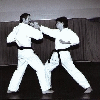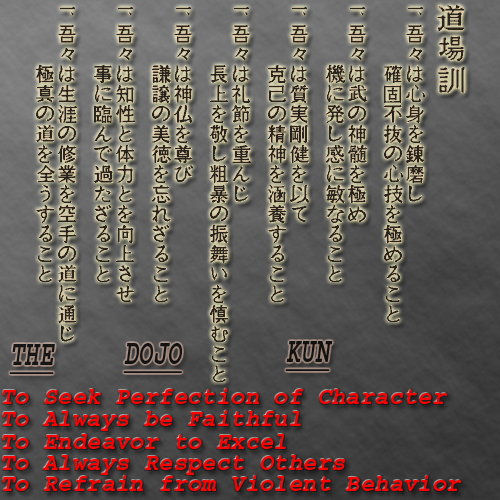|
|||
|
| -Countries |
| -Dictionary |
| -Federations |
| -M.A. Timeline |
| -Number System |
| -Styles |
| -Weapons |
| -Who's Who |
| -Updates |
| -Credits |
| -Stats |
| -Webmaster |
| Shotokan
A brief history of the Shoto-kan Karate-do Five hundred years ago, the use of weapons in Ryukyu Islands, now Okinawa Prefecture, was prohibited. As a result of this decree, forms of self-defense emerged and were performed with the body as a weapon.
Those self-defense forms were originated and developed by the citizens who lived in those regions and with the influence of nearby cultures such as China. Weapons in Okinawa were prohibited by its government two times in its history. The second time when they were banned was two centuries ago by Shimazu, the leader of the Satsuma clan. When he reissued the decree of banning weapons in Ryukyu Islands, Ryukyuans continued secretly to practice forms of self-defense as their ancestors had done. Because there was influence from China on the Ryukyu Islands, it is believed that some forms of self-defense like kempo (``boxing'') were exported into the islands, and also philosophical teachings produced in the ancient culture of China were introduced to the Ryukyu Islands. The self -defense methods were transmitted through generations not only in the Ryukyu Islands but also in China, Korea, Japan, etc. One of the most important self-defense methods until now is karate. Even though its origin is lost in the darkness of time since there is no written evidence of the early history of it, some Okinawans practiced karate religiously and became masters of this art. Although karate was prohibited by the government in the nineteenth century, a small part of the Okinawan population practiced it and they developed a sort of karate which is called karate-do. Since do means ``Way'', karate-do may be traduced as ``the Way of karate.''
At that time, one of the few students who had studied karate-do since his early childhood was Master Gichin Funakoshi. He was a student of one of Okinawa's gratest experts in the art of karate-do, Master Yasutsune Azato. Master Funakoshi was also a pupil of Master Itosu who was considered to be a proficient karateka and a friend of Master Azato. Master Funakoshi learned from those masters the fundamentals of the art of karate-do in its spiritual and in its physical conceptions. At the end of 1921, karate-do was introduced in the principal cities of Japan by Master Funakoshi. He developed, taught and diffused a sort of karate-do which is known as Shoto-kan. After this date, Master Funakoshi announced a disagreement which established that the meaning of kara should be interpreted as Empty instead of being interpreted as Chinese. Furthermore, he made a suggestion that the art of karate be renamed Dai Nippon Kempo Karate-do, which may be translated ``Great Japan Fist-Method Empty-Hands Way.'' Because Shoto-kan had a great popularity in Japan, and later around the world, Sensei Funakoshi is considered to be the ``father of modern karate-do. House of Pine Waves In 1939, Funakoshi's students constructed the
first karate dojo. Over the door, there was a plaque that
read "Shotokan". Even though the dojo was built
in honor of Funakoshi, it was destroyed in an American Bombing
raid in 1945 and was never rebuilt.| Physical Training Kihon, kumite, and kata are the elements which belong to the physical training in Shoto-kan. ``Kihon'' (basics) combines the fundamentals of the technique in Karate-do, which are: dachi (stances), tsuki (punching), uke (blocking), uchi (striking), and geri (kicking). In this part of the training the person learns, develops, and trains in the technique of karate art. ``Kumite'' (sparring) is developing distance and time in a match between two people.
A good training of ``Kata'' (forms) develops the perfection of the technique and the ability to perform the basics fluently. A kata can be practiced as if it were a dance because its training requires a patron of time, fluent movements and perfect technique. In fact, Okinawan folk dances employ similar movements to karate. This common characteristic between a ``Kata'' and an Okinawan folk dance induced Master Funakoshi to conjecture that those movements were incorporated into karate in order to make believe that what they were practicing was a dance instead of karate. The purpose of this trick was to confuse the police because practicing karate was banned by the government. Training of Mind ``The mind of a true karateka should be imbued with such concern before he turns his attention to his body and the refinement of his technique.'' Karate is not only the physical training but also the mind focused on being a good and honest person. The capacity of physical training that someone can have in karate is not important if there is a lack of humility in him. The purpose of karate is not to prevail over others. When someone shows up or braggs about his ability and strong body, that person not only dishonors himself but also dishonors the art of karate. Also, it is implied that karate is a self-defense martial art, so the person has to develop self control, must be be sincere, and respect others in order to avoid using karate as an offensive martial art. By seeking perfection of each movement in the training, a true karateka is seeking perfection of his character. His physical techniques are the physical expressions of his thoughts and his mind. ``By polishing our karate practice we are polishing our own spirit or our own mentality.'' In karate-do, the true opponent of a karateka is himself. A true karateka has to surrender his fears and his indecisions by putting maximum effort into everything he does. When karate becomes a way of life, the karateka's actions and feelings change in order to be practitioner member of the human race. All of the above is summarized in the Dojo Kun, which is the code of conduct of karate. When reading Japanese inscriptions, you start from the top and read down, going from right to left. Every line begins with a character that means "one." Every line ends with the word koto, which literally means "thing." |

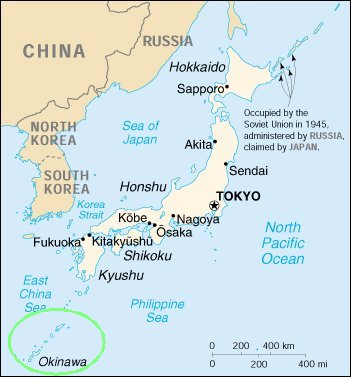 Figure 1: Location of the Ryukyu Islands
Figure 1: Location of the Ryukyu Islands
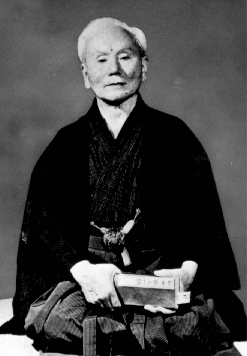
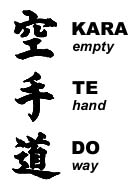 A
Japanese character can have different pronounciations depending
on the use, and unrelated signs can have the same pronunciation
even if they have unlike meanings. Thus, Karate can have two
different meanings. It is a composed word where te simply
means hand(s). However, depending on how kara
is pronounced, it can be connected with two signs whose meanings
differ. One of those two signs means Empty, and the other
is a Chinese character which should be translated as Chinese.
Until 1920 in Okinawa, kara was related to the sign which
means Chinese.
A
Japanese character can have different pronounciations depending
on the use, and unrelated signs can have the same pronunciation
even if they have unlike meanings. Thus, Karate can have two
different meanings. It is a composed word where te simply
means hand(s). However, depending on how kara
is pronounced, it can be connected with two signs whose meanings
differ. One of those two signs means Empty, and the other
is a Chinese character which should be translated as Chinese.
Until 1920 in Okinawa, kara was related to the sign which
means Chinese.
 If
you look at the picture, the word Shotokan contains three characters
(Kanji). The first character, "sho" which means pine
tree. "To" is the character for waves. Pine Waves
literaly translates as "the sound that pine trees make
when the wind blows through their needles." Gichin Funakoshi
signed his works of calligraphy with the pen name Shoto. The
word kan translates to building. Put both of those words together
and you get the building in which Funakoshi taught karate.
If
you look at the picture, the word Shotokan contains three characters
(Kanji). The first character, "sho" which means pine
tree. "To" is the character for waves. Pine Waves
literaly translates as "the sound that pine trees make
when the wind blows through their needles." Gichin Funakoshi
signed his works of calligraphy with the pen name Shoto. The
word kan translates to building. Put both of those words together
and you get the building in which Funakoshi taught karate.
